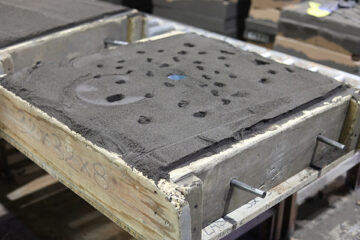The pouring of large castings involves a carefully orchestrated process to ensure the proper filling of the mold and the quality of the final casting. Here is a general overview of the steps involved in pouring large castings:
– Before pouring, a mold must be prepared. For large castings, the mold is typically made from a mixture of sand and binders. The mold is created in sections, and the patterns are positioned within the mold to form cavities for the casting.
2. Core Production (if needed):
– Cores, which are inserts made of sand or other materials, may be used to create internal features of the casting, such as hollow sections or complex geometries. Cores are placed in the mold before pouring.
3. Assembly of Mold Sections:
– The mold sections are assembled, creating a complete mold. The mold may consist of multiple sections that are carefully aligned to create the desired shape of the casting.
4. Mold Coating:
– The interior surfaces of the mold are coated with a refractory material to improve the surface finish of the casting and provide better heat resistance.
5. Preheating the Mold:
– Large molds are often preheated before pouring. Preheating helps prevent thermal shock when the hot metal is introduced, which can affect the quality of the casting.
6. Molten Metal Preparation:
– The metal for the casting, often an alloy like steel, aluminum, or iron, is melted in a furnace. The molten metal is brought to the proper pouring temperature and maintained to ensure consistency.
– A pouring system, including a ladle and a system of channels, gates, and risers, is set up to deliver the molten metal to the mold. The pouring system must be designed to ensure a controlled and uniform flow of metal into the mold cavity.
– The molten metal is poured into the mold cavity through the pouring system. The pouring process must be controlled to prevent turbulence and ensure complete filling of the mold.
9. Solidification:
– After pouring, the molten metal starts to cool and solidify within the mold. The solidification process may take a significant amount of time for large castings.
10. Mold Breakout:
– Once the metal has solidified, the sand mold is broken apart to reveal the rough casting. The casting is removed from the mold, and any sand or other materials are cleaned off.
11. Cutting and Finishing:
– The casting undergoes cutting and finishing processes to remove excess material, such as gates and risers. Additional finishing processes like machining, grinding, or heat treatment may be applied to achieve the desired specifications.
12. Inspection and Quality Control:
– The finished casting is inspected for dimensional accuracy, surface finish, and any defects. Non-destructive testing methods may be employed to ensure the integrity of the casting.
Pouring large castings requires expertise in metallurgy, process control, and mold design. The size and complexity of the casting, along with the properties required, influence the choice of materials, pouring techniques, and other aspects of the process. Manufacturers may use different methods, such as sand casting, investment casting, or other specialized casting processes, depending on the specific requirements of the application.

